Agro Climatic Zoning of Saffron Culture in Miyaneh City by Using WLC Method and Remote Sensing Data
Abstract
:1. Introduction
2. Materials and Methods
2.1. Study Area
2.2. Areas Prone to Cultivating Saffron in Miyaneh City
2.3. Dataset
2.3.1. Field Data
2.3.2. Satellite Data
2.4. Weighted Linear Combination (WLC) Method
3. Results
3.1. Results of the Weighted Linear Composition Method (WLC)
3.1.1. Soil Type
3.1.2. Soil Slop
3.1.3. Soil Moisture
3.1.4. Soil Salinity
3.2. Soil Zoning
4. Discussion
4.1. The Effect of Soil Texture on the Identification of Suitable Areas to Saffron Cultivation
4.2. The Effect of Slope on the Identification of Suitable Areas to Saffron Cultivation
4.3. The Effect of Amount of Water on the Identification of Suitable Areas to Saffron Cultivation
4.4. The Effect of Salinity on the Identification of Suitable Areas to Saffron Cultivation
4.5. Weighted Linear Composition Method (WLC)
5. Conclusions
Author Contributions
Funding
Institutional Review Board Statement
Informed Consent Statement
Data Availability Statement
Conflicts of Interest
References
- Cao, Z.; Ma, R.; Duan, H.; Xue, K.; Shen, M. Effect of Satellite Temporal Resolution on Long-Term Suspended Particulate Matter in Inland Lakes. Remote Sens. 2019, 11, 2785. [Google Scholar] [CrossRef] [Green Version]
- Chamkhi, I.; Abbas, Y.; Tarmoun, K.; Aurag, J.; Sbabou, L. Morphological and Molecular Characterization of Arbuscular Mycorrhizal Fungal Communities Inhabiting the Roots and the Soil of Saffron (Crocus sativus L.) under Different Agricultural Management Practices. Arch. Agron. Soil Sci. 2019, 65, 1035–1048. [Google Scholar] [CrossRef]
- Hong, S.Y.; Park, J.H.; Cho, S.H.; Yang, M.S.; Park, C.M. Phenological Growth Stages of Brachypodium Distachyon: Codification and Description. Weed Res. 2011, 57, 612–620. [Google Scholar] [CrossRef]
- Kosari, A.; Sharifi, A.; Ahmadi, A.; Khoshsima, M. Remote Sensing Satellite’s Attitude Control System: Rapid Performance Sizing for Passive Scan Imaging Mode. Aircr. Eng. Aerosp. Technol. 2020, 92, 1073–1083. [Google Scholar] [CrossRef]
- Felegari, S.; Sharifi, A.; Moravej, K.; Amin, M.; Golchin, A.; Muzirafuti, A.; Tariq, A.; Zhao, N. Integration of Sentinel 1 and Sentinel 2 Satellite Images for Crop Mapping. Appl. Sci. 2021, 11, 10104. [Google Scholar] [CrossRef]
- Cardone, L.; Castronuovo, D.; Perniola, M.; Scrano, L.; Cicco, N.; Candido, V. The influence of soil physical and chemical properties on saffron (Crocus sativus L.) growth, yield and quality. Agronomy 2020, 10, 1154. [Google Scholar] [CrossRef]
- Koocheki, A.A. Indigenous knowledge in agriculture with particular reference to saffron production in Iran. Acta Hortic. 2004, 650, 175–182. [Google Scholar] [CrossRef]
- Garcia-Rodriguez, M.V.; Lopez-Corcoles, H.; Alonso, G.L.; Pappas, C.S.; Polissiou, M.G.; Tarantilis, P.A. Comparative evaluation of an ISO 3632 method and an HPLC-DAD method for safranal quantity determination in saffron. Food Chem. 2017, 221, 838–843. [Google Scholar] [CrossRef]
- Maleki, F.; Kazemi, H.; Siahmarguee, A.; Kamkar, B. Development of a Land Use Suitability Model for Saffron (Crocus sativus L.) Cultivation by Multi-Criteria Evaluation and Spatial Analysis. Ecol. Eng. 2017, 106, 140–153. [Google Scholar] [CrossRef]
- Mehrara, M.; Baghbanpour, J. The Contribution of Industry and Agriculture Exports to Economic Growth: The Case of Developing Countries. World Sci. News 2016, 46, 100–111. [Google Scholar]
- Melnyk, J.; Wang, S.; Massimo, M. Chemical and Biological Properties of the World’s Most Expensive Spice: Saffron. Food Res. Int. 2010, 43, 1981–1989. [Google Scholar] [CrossRef]
- Mirjavadi, A.; Abdollah Karimi, L.; Azimi, R.; Ghanaiee, M.; Shamshiri, A.; Tariverdi, M. Livestock Brucellosis: Frequency of Mutations Causing Resistance to Fluoroquinolone, Streptomycin and Rifampin. Arch. Pediatric Infect. Dis. 2020, 8, 213–242. [Google Scholar] [CrossRef]
- Moghaddasi, M. Saffron Chemicals and Medicine Usage. J. Med. Plants Res. 2011, 8, 84–97. [Google Scholar]
- Sharifi, A. Using Sentinel-2 Data to Predict Nitrogen Uptake in Maize Crop. IEEE J. Sel. Top. Appl. Earth Obs. Remote Sens. 2020, 13, 2656–2662. [Google Scholar] [CrossRef]
- Sharifi, A.; Amini, J.; Sri Sumantyo, J.T.; Tateishi, R. Speckle Reduction of PolSAR Images in Forest Regions Using Fast ICA Algorithm. J. Indian Soc. Remote Sens. 2015, 43, 339–346. [Google Scholar] [CrossRef]
- Yusoff, N.M.; Muharam, F.M.; Khairunniza-Bejo, S. Towards the use of remote-sensing data formonitoring of abandoned oil palm lands in Malaysia: A semi-automatic approach. Int. J. Remote Sens. 2017, 38, 432–449. [Google Scholar] [CrossRef]
- Sharifi, A. Remotely sensed vegetation indices for crop nutrition mapping. J. Sci. Food Agric. 2020, 100, 5191–5196. [Google Scholar] [CrossRef] [PubMed]
- Hopkins, L. Methods for generating land suitability maps: A comparative evaluation. J. Am. Inst. Plan. 1977, 34, 19–29. [Google Scholar] [CrossRef]
- Badihi, L.; Gerami, M.; Akbarinodeh, D.; Shokrzadeh, M.; Ramezani, M. Physio-chemical responses of exogenous calcium nanoparticle and putrescine polyamine in Saffron (Crocus sativus L.). Physiol. Mol. Biol. Plants 2021. [Google Scholar] [CrossRef]
- Massam, B.H. Multi-criteria decision making (MCDM) techniques in planning. Prog. Plan. 1988, 30, 1–84. [Google Scholar] [CrossRef]
- Sharifi, A.; Moradi, E. A Methodology for Radiometric Calibration of Remote Sensing Images. In Proceedings of the 38th Asian Conference on Remote Sensing—Space Applications: Touching Human Lives (ACRS), New Delhi, India, 23–27 October 2017. [Google Scholar]
- Can, M. Fuzzy Multiple Objective Models for Facility Location Problems Fuzzy Multiple Objective Models for Facility Location Problems. Southeast Eur. J. Soft Comput. 2012. [Google Scholar] [CrossRef]
- Moradi, E.; Sharifi, A. Assessment of forest cover changes using multi-temporal Landsat observation. Environ. Dev. Sustain. 2022. [Google Scholar] [CrossRef]
- Yin, S.; Li, J.; Liang, J.; Jia, K.; Yang, Z.; Wang, Y. Optimization of the Weighted Linear Combination Method for Agricultural Land Suitability Evaluation Considering Current Land Use and Regional Differences. Sustainability 2020, 12, 10134. [Google Scholar] [CrossRef]
- Al-Hamed, S.A.; Wahby, M.F.; Aboukarima, A.M.; El Marazky, M.S. Effect of soil and water characteristics on yield and properties of ‘Spunta’ potatoes. Chil. J. Agric. Res. 2017, 77, 250–256. [Google Scholar] [CrossRef] [Green Version]
- Fu, X.; Wang, X.; Yang, Y.J. Deriving suitability factors for CA-Markov land use simulation model based on local historical data. J. Environ. Manag. 2018, 206, 10–19. [Google Scholar] [CrossRef] [PubMed]
- Sereshti, H.; Ataolahi, S.; Aliakbarzadeh, G.; Zarre, S.; Poursorkh, Z. Evaluation of storage time effect on saffron chemical profile using gas chromatography and spectrophotometry techniques coupled with chemometrics. J. Food Sci. Technol. 2018, 55, 1350–1359. [Google Scholar] [CrossRef] [PubMed]
- Fallahi, H.R.; Aghhavani-Shajari, M.; Sahabi, H.; Behdani, M.A.; Sayyari-Zohan, M.H.; Vatandoost, S. Influence of some pre and post-harvest practices on quality of saffron stigmata. Sci. Hortic. 2021. [Google Scholar] [CrossRef]
- Ghanbari, J.; Khajoei-Nejad, G.; van Ruth, S.M.; Aghighi, S. The possibility for improvement of flowering, corm properties, bioactive compounds, and antioxidant activity in saffron (Crocus sativus L.) by different nutritional regimes. Ind. Crops Prod. 2019, 135, 301–310. [Google Scholar] [CrossRef]
- Rhebergena, T.; Fairhurstc, T.; Zingorea, S.; Fisherd, M.; Oberthüre, T.; Whitbread, A. Climate, soil and land-use based land suitability evaluation for oil palm production in Ghana. Eur. J. Agron. 2016, 81, 1–14. [Google Scholar] [CrossRef] [Green Version]
- Yalew, S.G.; van Griensven, A.; van der Zaag, P. AgriSuit: A web-based GIS-MCDA framework for agricultural land suitability assessment. Comput. Electron. Agric. 2016, 128, 1–8. [Google Scholar] [CrossRef]
- Behzad, S.; Razavi, M.; Mahajeri, M. The effect of various amounts of ammonium phosphate and urea on saffron production. Acta Hortic. 1992, 306, 337–339. [Google Scholar] [CrossRef]
- Giorgi, A.; Pentimalli, D.; Giupponi, L.; Panseri, S. Quality traits of saffron (Crocus sativus L.) produced in the Italian Alps. Open Agric. 2017, 2, 52–57. [Google Scholar] [CrossRef] [Green Version]
- Lone, R.; Shuab, R.; Koul, K. AMF association and their effect on metabolite mobilization, mineral nutrition and nitrogen assimilating enzymes in saffron (Crocus sativus) plant. J. Plant Nutr. 2016, 39, 1852–1862. [Google Scholar] [CrossRef]
- Kabiri, M.; Rezadoost, H.; Ghassempour, A. A comparative quality study of saffron constituents through HPLC and HPTLC methods followed by isolation of crocins and picrocrocin. LWT 2017, 84, 1–9. [Google Scholar] [CrossRef]
- Azami, S.; Shahriari, Z.; Asgharzade, S.; Farkhondeh, T.; Sadeghi, M.; Ahmadi, F.; Vahedi, M.M.; Forouzanfar, F. Therapeutic Potential of Saffron (Crocus sativus L.) in Ischemia Stroke. Evidence-based Complement. Altern. Med. 2021. [Google Scholar] [CrossRef] [PubMed]
- Feizi, H.; Moradi, R.; Pourghasemian, N.; Sahabi, H. Assessing saffron response to salinity stress and alleviating potential of gamma amino butyric acid, salicylic acid and vermicompost extract on salt damage, South African. J. Bot. 2021, 141, 330–343. [Google Scholar] [CrossRef]
- Dastranj, M.; Sepaskhah, A. Response of saffron (Crocus sativus L.) to irrigation water salinity, irrigation regime and planting method: Physiological growth and gas exchange. Sci. Hortic. 2019, 257, 354–367. [Google Scholar] [CrossRef]
- Mzabri, I.; Legsayer, M.; Kouddane, N.; Boukroute, A.; Berrichi, A. Salt stress effects on some morphological, physiological and biochemical parameters of saf-fron plant (Crocus sativus L.) in Eastern Morocco. J. Mater. Environ. Sci. 2017, 8, 4894–4901. [Google Scholar]
- Pilevar, A.R.; Matinfar, H.R.; Sohrabi, A.; Sarmadian, F. Integrated fuzzy, AHP and GIS techniques for land suitability assessment in semi-arid regions for wheat and maize farming. Ecol. Indic. 2020, 110, 105–127. [Google Scholar] [CrossRef]
- Siddiqui, M.Z.; Everett, J.W.; Vieux, B.E. Landfill siting using geographic information systems: A demonstration. J. Environ. Eng. 1996, 122, 515–523. [Google Scholar] [CrossRef]
- Hu, P.; Sharifi, A.; Tahir, M.N.; Tariq, A.; Zhang, L.; Mumtaz, F.; Shah, S.H.I.A. Evaluation of Vegetation Indices and Phenological Metrics Using Time-Series MODIS Data for Monitoring Vegetation Change in Punjab, Pakistan. Water 2021, 13, 2550. [Google Scholar] [CrossRef]
- Shah, S.H.I.A.; Yan, J.; Ullah, I.; Aslam, B.; Tariq, A.; Zhang, L.; Mumtaz, F. Classification of Aquifer Vulnerability by Using the DRASTIC Index and Geo-Electrical Techniques. Water 2021, 13, 2144. [Google Scholar] [CrossRef]
- Kiani, S.; Minaei, S.; Ghasemi-Varnamkhasti, M. Instrumental approaches and innovative systems for saffron quality assessment. J. Food Eng. 2018, 216, 1–10. [Google Scholar] [CrossRef]
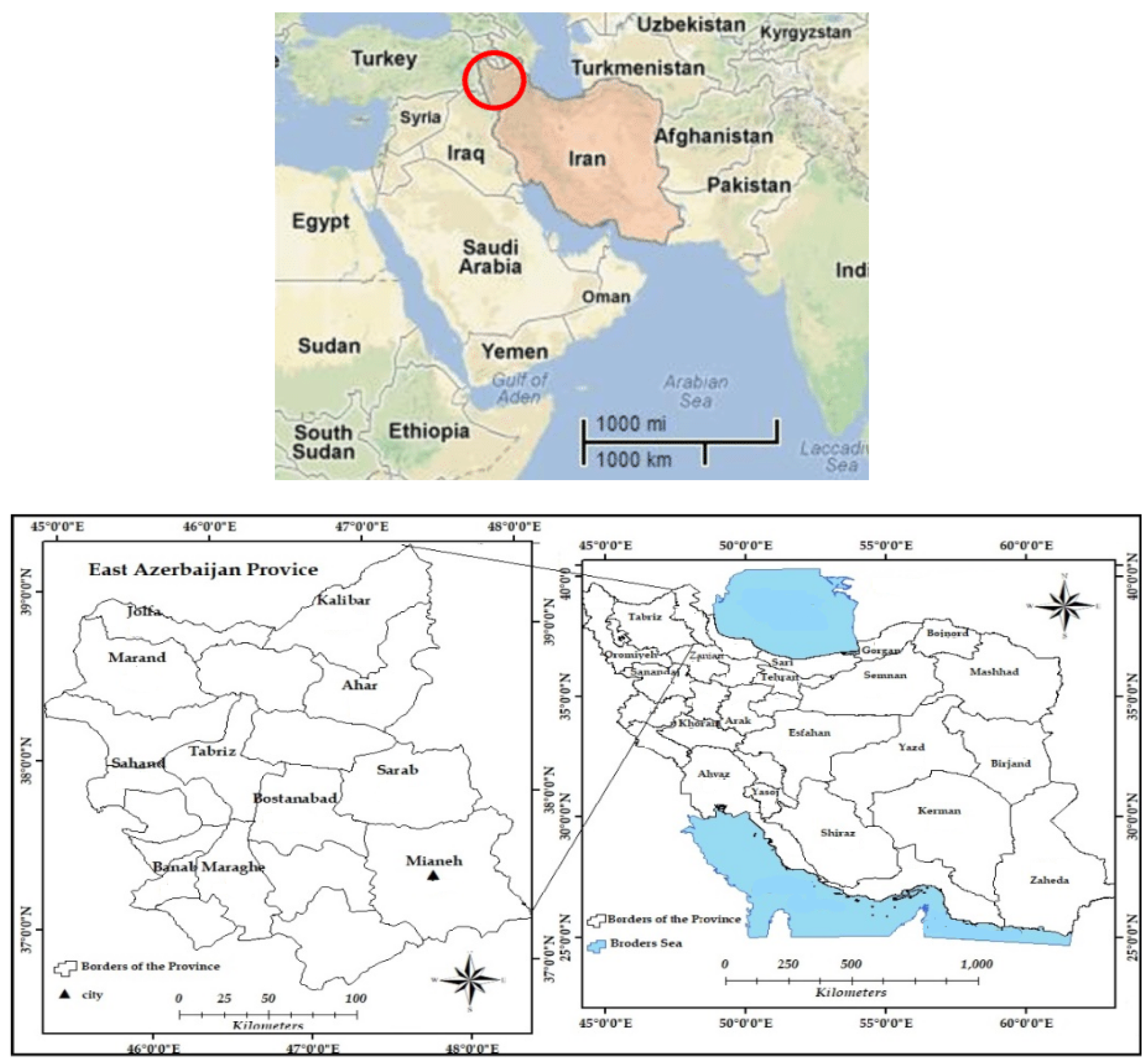
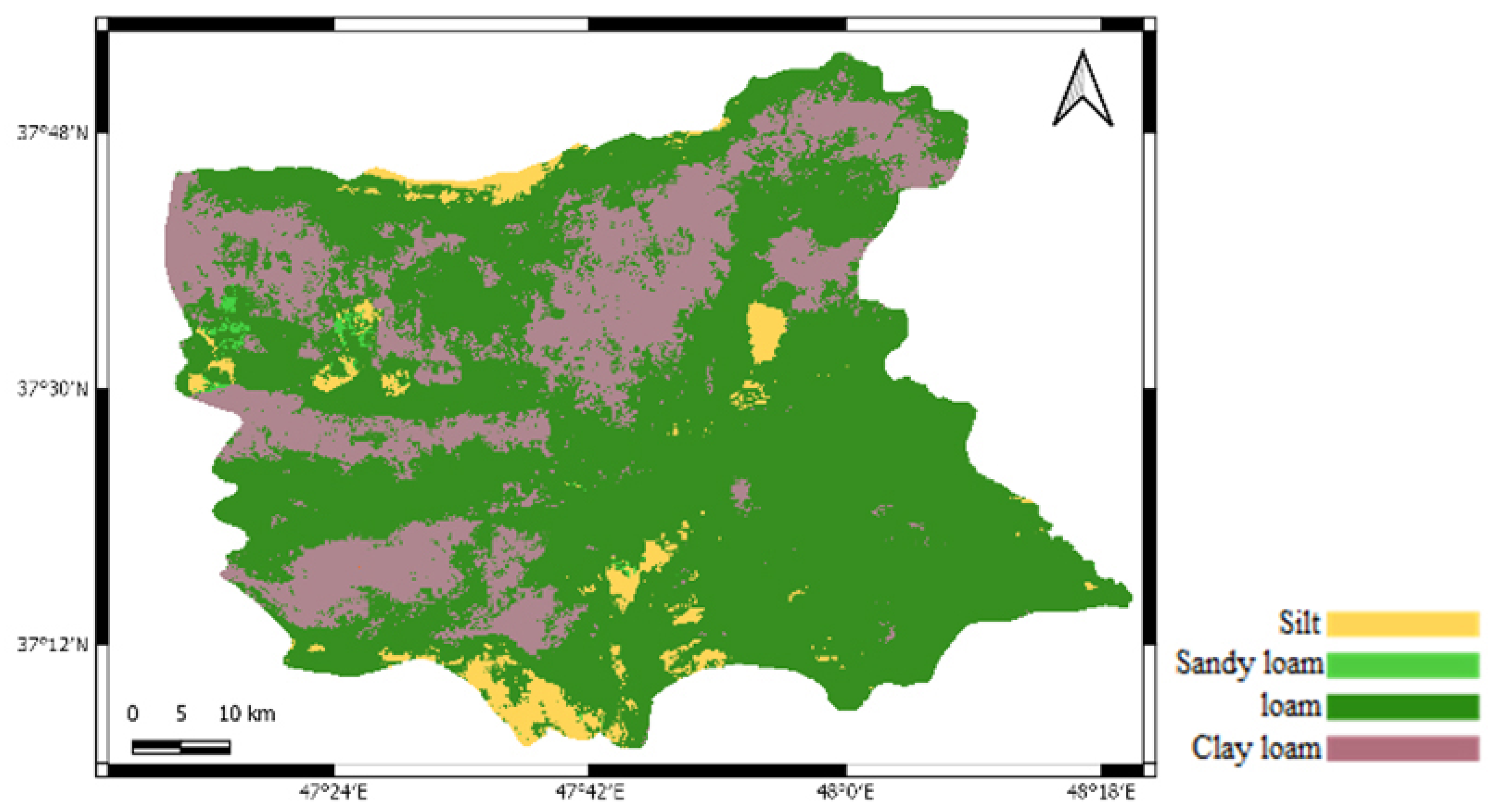
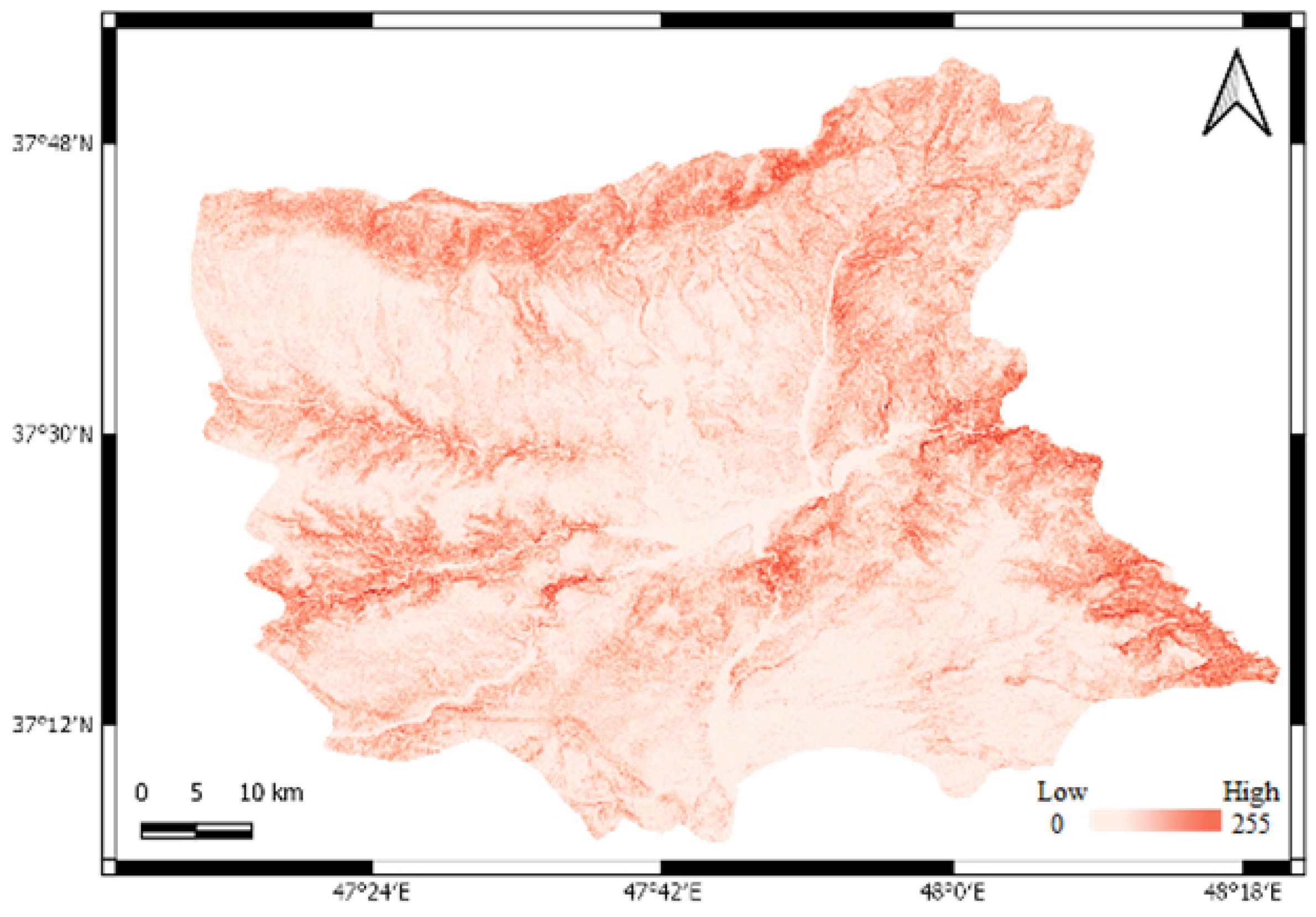

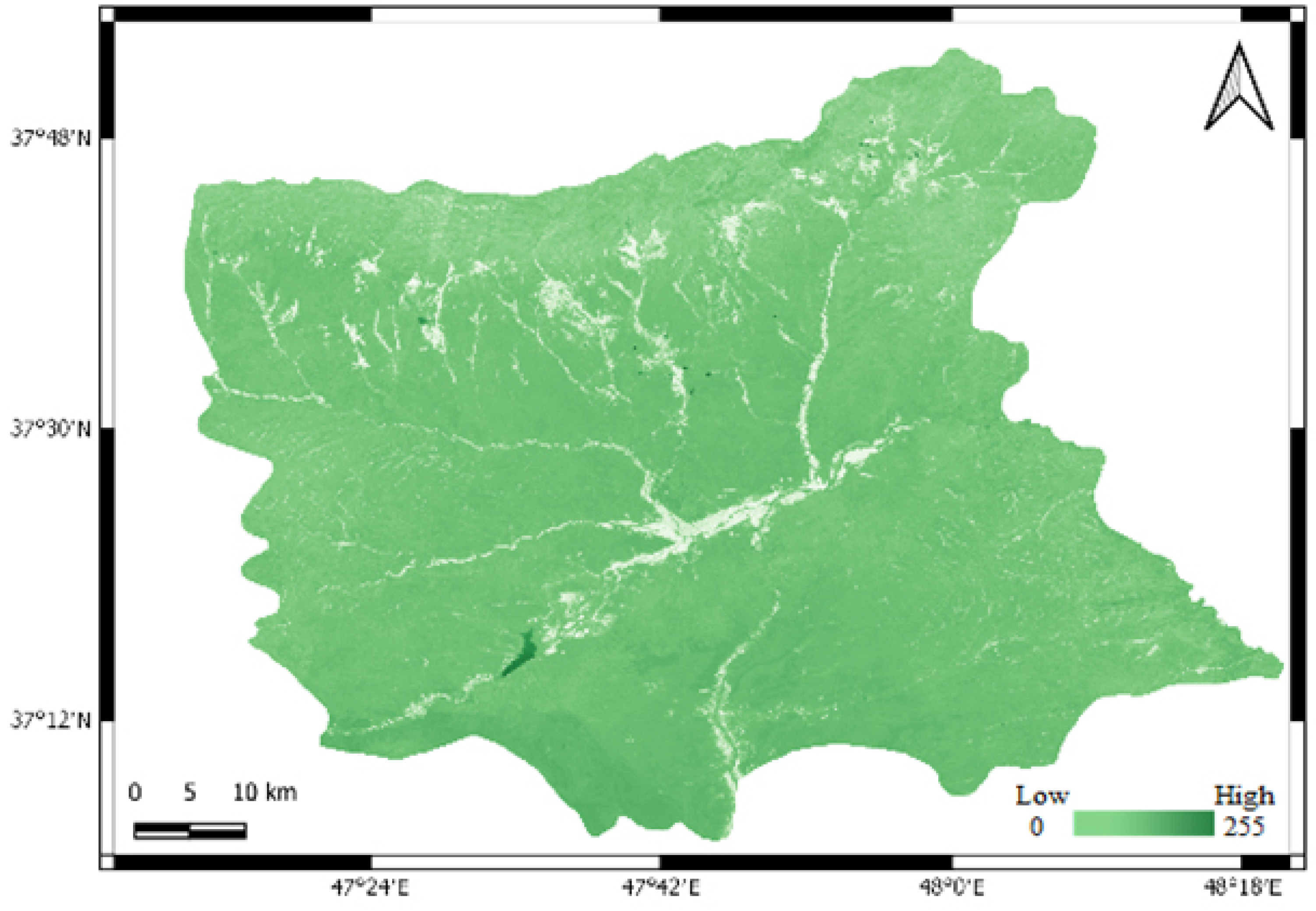
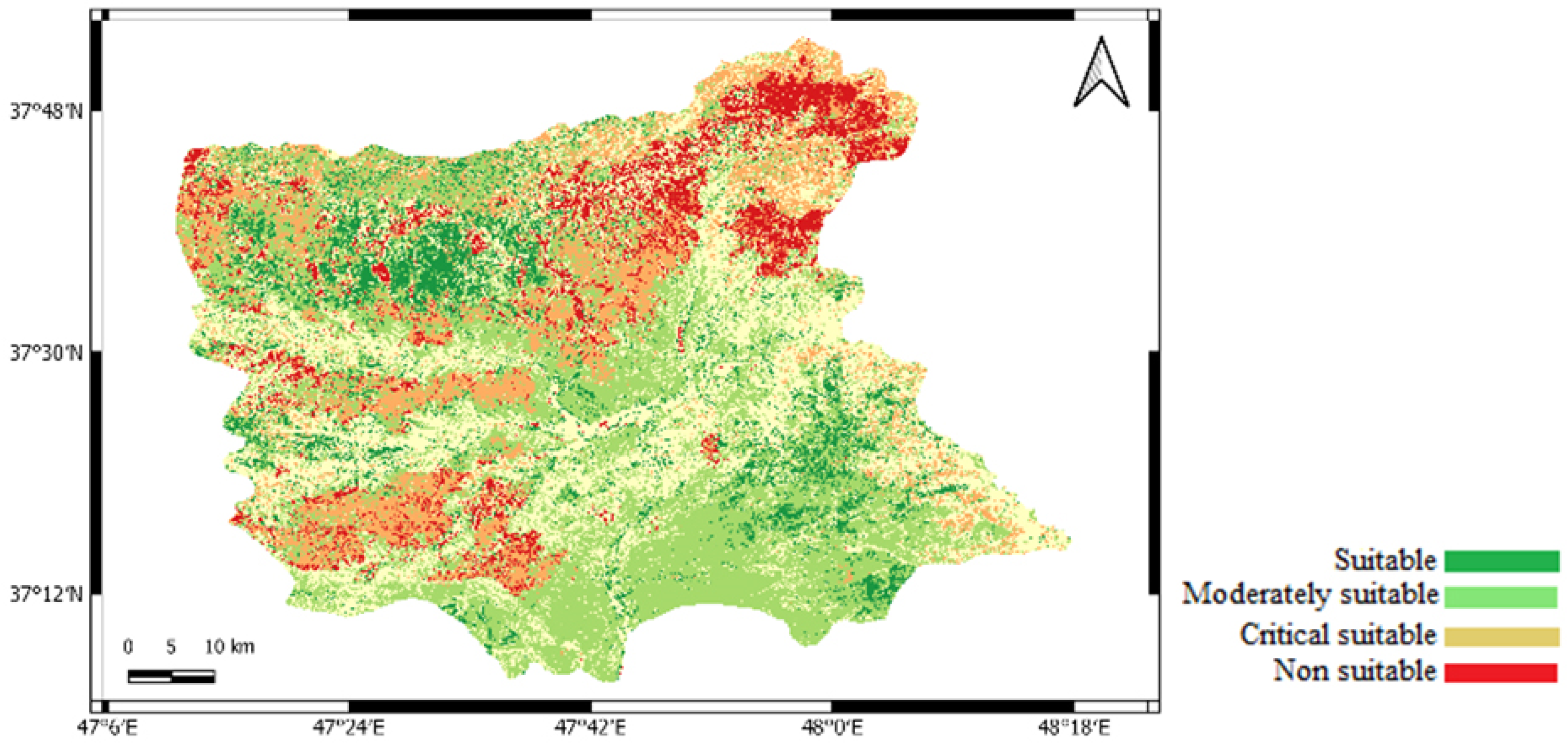
| Class | Suitable | Moderately Suitable | Critical Suitable | Non Suitable |
|---|---|---|---|---|
| Slope for surface | 0–2 | 2–5 | 5–8 | >8 |
| Soil texture | Heavy | Medium | Light | Very heavy |
| EC (ds/m) | 4 < EC < 8 | 8 < EC < 16 | 16 < EC < 32 | EC > 32 |
| Irrigation capability | I | II–III | IV | V–VI |
| Lands that are suitable for surface irrigation by performing construction and corrective operations. | Lands that are expected to be moderately suitable for irrigated agriculture through construction and remediation operations. | Lands that are expected to be relatively unsuitable for irrigated agriculture through construction and remediation operations. | The irrigation capability of these lands is not clear in the current situation. |
| Bands | OIF Index Highest Ranking |
|---|---|
| Band 7, Band5, Band6 | 5326.46 |
| Band4, Band5, Band6 | 5197.78 |
| Band1, Band5, Band6 | 5134.22 |
| Band4, Band6, Band7 | 5121.60 |
| Band2, Band5, Band6 | 5086.73 |
| Band3, Band5, Band6 | 5073.36 |
Publisher’s Note: MDPI stays neutral with regard to jurisdictional claims in published maps and institutional affiliations. |
© 2022 by the authors. Licensee MDPI, Basel, Switzerland. This article is an open access article distributed under the terms and conditions of the Creative Commons Attribution (CC BY) license (https://creativecommons.org/licenses/by/4.0/).
Share and Cite
Zamani, A.; Sharifi, A.; Felegari, S.; Tariq, A.; Zhao, N. Agro Climatic Zoning of Saffron Culture in Miyaneh City by Using WLC Method and Remote Sensing Data. Agriculture 2022, 12, 118. https://doi.org/10.3390/agriculture12010118
Zamani A, Sharifi A, Felegari S, Tariq A, Zhao N. Agro Climatic Zoning of Saffron Culture in Miyaneh City by Using WLC Method and Remote Sensing Data. Agriculture. 2022; 12(1):118. https://doi.org/10.3390/agriculture12010118
Chicago/Turabian StyleZamani, Ali, Alireza Sharifi, Shilan Felegari, Aqil Tariq, and Na Zhao. 2022. "Agro Climatic Zoning of Saffron Culture in Miyaneh City by Using WLC Method and Remote Sensing Data" Agriculture 12, no. 1: 118. https://doi.org/10.3390/agriculture12010118
APA StyleZamani, A., Sharifi, A., Felegari, S., Tariq, A., & Zhao, N. (2022). Agro Climatic Zoning of Saffron Culture in Miyaneh City by Using WLC Method and Remote Sensing Data. Agriculture, 12(1), 118. https://doi.org/10.3390/agriculture12010118








